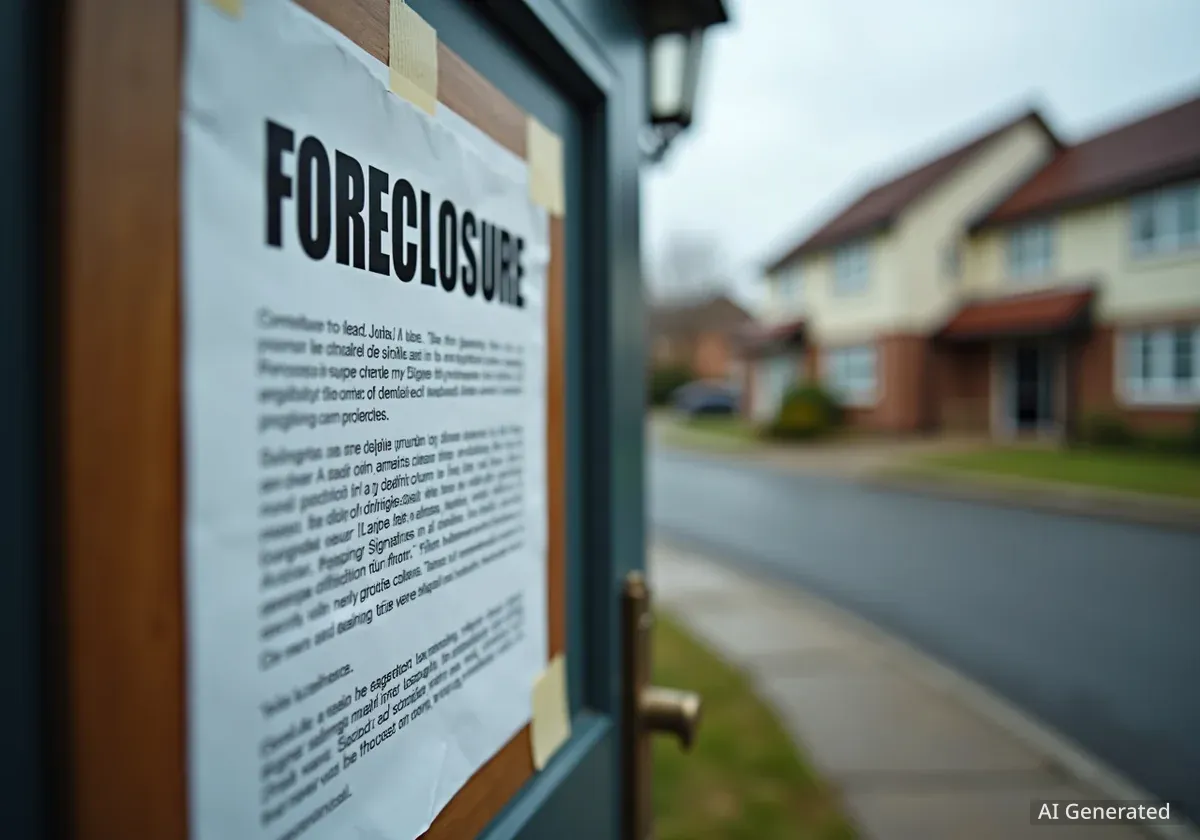The U.S. housing market is presenting a complex picture for potential buyers and sellers. Despite a recent dip in mortgage rates and an increase in available homes, buyer demand has softened. Compounding this uncertainty, new data reveals a significant rise in foreclosure activity, signaling potential distress for some homeowners.
Key Takeaways
- Foreclosure filings have increased by 17% compared to the same period last year, according to a recent report from ATTOM.
- Bank repossessions (REOs) have seen an even sharper rise, jumping 33% year-over-year.
- Despite more homes entering the market and slightly lower mortgage rates, overall buyer demand has weakened.
- The Federal Reserve has indicated potential rate cuts in 2025, but Chair Jerome Powell clarified that directly tackling high home prices is not the central bank's mandate.
Foreclosure Activity on the Rise
A troubling trend is emerging in the housing sector as foreclosure rates climb from the historically low levels seen during the pandemic. According to a new report from real estate data firm ATTOM, foreclosure filings have surged 17% from a year ago. This category includes default notices, scheduled auctions, and bank repossessions.
The increase in completed foreclosures, where lenders repossess a property, is even more pronounced. These bank repossessions, also known as REOs, have jumped by 33% compared to the previous year. This uptick suggests that more homeowners are unable to meet their mortgage obligations as pandemic-era forbearance programs and moratoriums have expired.
Understanding the Data
The rise in foreclosures, while significant, is a return toward pre-pandemic norms rather than a sign of a widespread crisis similar to 2008. Many homeowners still possess substantial equity in their properties, which can help them avoid foreclosure by selling their home. However, the trend indicates growing financial strain for a segment of the population.
Analysts note that while the overall numbers are still below historical averages, the sharp year-over-year increase is a clear indicator of growing economic pressure on households. The end of government assistance programs combined with persistent inflation and high interest rates has created a challenging environment for some homeowners.
A Disconnect Between Supply and Demand
In a seemingly contradictory development, conditions that typically favor buyers have not sparked a surge in market activity. More homes are being listed for sale, providing greater inventory and choice for prospective buyers. Simultaneously, mortgage rates have experienced a slight downturn, offering a small measure of relief from the high borrowing costs that have sidelined many.
However, this improved supply and marginal rate relief have failed to translate into stronger demand. Many would-be buyers remain on the sidelines, discouraged by home prices that are still near record highs. The cumulative effect of years of price appreciation and elevated mortgage rates has pushed affordability to its lowest point in decades, effectively locking a large number of potential buyers out of the market.
By the Numbers
- 17% Increase: Year-over-year rise in overall foreclosure filings.
- 33% Increase: Year-over-year jump in bank repossessions of homes.
- Affordability Strain: Despite some positive signs, homeownership remains out of reach for many due to the combination of high prices and interest rates.
This weakening demand creates a challenging situation for sellers. While they may have significant equity, they are now facing a less competitive market where buyers are more cautious and have more negotiating power. The days of multiple offers well above the asking price are becoming less common in many regions across the country.
The Federal Reserve's Position
All eyes remain on the Federal Reserve as it navigates its monetary policy. The central bank has signaled a potential willingness to consider interest rate cuts in 2025, which could provide further relief for mortgage rates. The Fed's benchmark federal funds rate influences the broader economy, including the long-term interest rates that determine mortgage costs.
Further cuts to the short-term rate could push mortgage rates down, potentially improving affordability and stimulating some demand. However, Fed Chair Jerome Powell has been careful to manage expectations. In recent comments, he emphasized the central bank's primary focus on inflation and employment, not on directly manipulating housing prices.
"Our tools are aimed at achieving maximum employment and stable prices," Powell noted, adding that tackling high home prices is "not what we do."
This statement underscores that while the Fed's actions have a profound impact on the housing market, any relief for homebuyers will be a byproduct of its broader economic goals, not the primary objective. The Fed also remains watchful of risks in the labor market, as a significant downturn in employment could further dampen housing demand and increase foreclosure risk.
What This Means for the Market
The current U.S. housing market is in a state of delicate rebalancing. The combination of rising inventory and softer demand is beginning to shift the dynamics away from the extreme seller's market of the past few years.
For Homebuyers
Potential buyers may find more options and face less competition. The ability to negotiate on price and request concessions like inspections or repairs may return. However, the fundamental challenge of affordability remains the biggest hurdle. Even with slightly lower rates, monthly payments are substantially higher than they were just a few years ago.
For Homeowners and Sellers
Sellers need to adjust their expectations. Pricing a home correctly from the start is now more critical than ever. Properties that are overpriced are likely to sit on the market longer. For homeowners facing financial difficulty, the rising equity of recent years may provide a lifeline, allowing them to sell their property and avoid foreclosure. The increasing number of foreclosures, however, highlights the severe strain some are experiencing.
Ultimately, the market is sending mixed signals. While some pressures are easing, the core issues of high prices and economic uncertainty continue to shape the housing landscape. The path forward will likely depend on the Federal Reserve's next moves, the strength of the labor market, and whether home price growth finally moderates to a more sustainable level.





